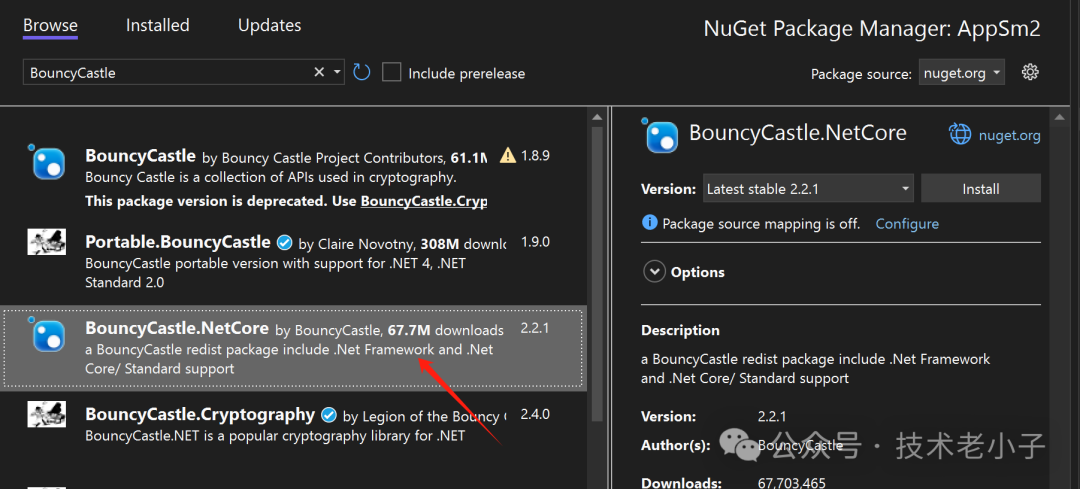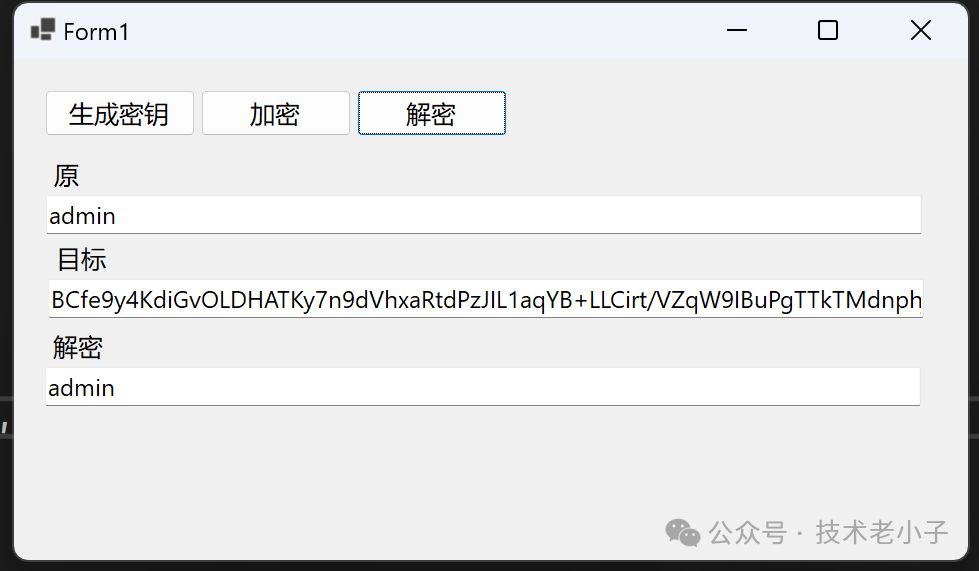SM2是由中國(guó)國(guó)家密碼管理局制定的公鑰密碼算法,屬于國(guó)家密碼標(biāo)準(zhǔn)之一。SM2算法基于橢圓曲線密碼學(xué),兼具安全性和高效性,被廣泛應(yīng)用在金融、電子政務(wù)和電子商務(wù)等領(lǐng)域。
特點(diǎn)
安全性:SM2基于橢圓曲線密碼學(xué),提供高強(qiáng)度的安全保障。
高效性:在相同的安全強(qiáng)度下,SM2比RSA和DSA更加高效,計(jì)算復(fù)雜度較低。
國(guó)家標(biāo)準(zhǔn):SM2是中國(guó)國(guó)家密碼標(biāo)準(zhǔn)GB/T 32918,具有國(guó)家認(rèn)可的權(quán)威性。
應(yīng)用場(chǎng)景
數(shù)字簽名:用于身份驗(yàn)證和不可否認(rèn)性。
數(shù)據(jù)加密:用于保護(hù)敏感信息的傳輸與存儲(chǔ)。
密鑰交換:用于安全的密鑰分發(fā)和交換過程。
代碼示例
第三方庫BouncyCastle

using Org.BouncyCastle.Asn1.X9;using Org.BouncyCastle.Crypto.Generators;using Org.BouncyCastle.Crypto;using Org.BouncyCastle.Crypto.Parameters;using Org.BouncyCastle.Security;using Org.BouncyCastle.Asn1.Sec;using Org.BouncyCastle.Asn1.GM;using System.Security.Cryptography.X509Certificates;using Org.BouncyCastle.Crypto.Engines;using Org.BouncyCastle.Math;
namespace AppSm2{ public partial class Form1 : Form { public Form1() { InitializeComponent(); }
private void btnCreateKey_Click(object sender, EventArgs e) { // 1. 生成SM2密鑰對(duì) var keyPair = GenerateSM2KeyPair(); var publicKey = (ECPublicKeyParameters)keyPair.Public; var privateKey = (ECPrivateKeyParameters)keyPair.Private; File.WriteAllText("./public.dat", Convert.ToBase64String(publicKey.Q.GetEncoded())); File.WriteAllText("./private.dat", Convert.ToBase64String(privateKey.D.ToByteArrayUnsigned())); }
/// <summary> /// 生成公私鑰 /// </summary> /// <returns></returns> private AsymmetricCipherKeyPair GenerateSM2KeyPair() { // 使用國(guó)標(biāo)曲線參數(shù) "Wapi" 被GMNamedCurves定義 (SM2標(biāo)準(zhǔn)曲線) X9ECParameters sm2Params = GMNamedCurves.GetByName("sm2p256v1"); var ecParams = new ECDomainParameters(sm2Params.Curve, sm2Params.G, sm2Params.N, sm2Params.H);
var keyGenerationParameters = new ECKeyGenerationParameters(ecParams, new SecureRandom()); var keyPairGenerator = new ECKeyPairGenerator(); keyPairGenerator.Init(keyGenerationParameters);
return keyPairGenerator.GenerateKeyPair(); }
private void btnEncrypt_Click(object sender, EventArgs e) { // 將Base64格式公鑰轉(zhuǎn)換回ECPublicKeyParameters var restoredPublicKey = RestorePublicKeyFromBase64(File.ReadAllText("./public.dat")); byte[] cipherText = Encrypt(txt1.Text, restoredPublicKey); txt2.Text = Convert.ToBase64String(cipherText); }
/// <summary> /// 還原公鑰 /// </summary> /// <param name="base64PublicKey"></param> /// <returns></returns> private ECPublicKeyParameters RestorePublicKeyFromBase64(string base64PublicKey) { // 將Base64格式的公鑰字符串轉(zhuǎn)換為字節(jié)數(shù)組 byte[] publicKeyBytes = Convert.FromBase64String(base64PublicKey);
// 獲取SM2曲線參數(shù),這里使用sm2p256v1曲線 X9ECParameters sm2Params = GMNamedCurves.GetByName("sm2p256v1");
// 創(chuàng)建ECDomainParameters對(duì)象,包含曲線的一些基本參數(shù),如曲線、生成元G、階N和系數(shù)H var ecParams = new ECDomainParameters(sm2Params.Curve, sm2Params.G, sm2Params.N, sm2Params.H);
// 使用曲線參數(shù)解碼公鑰字節(jié)數(shù)組,將其轉(zhuǎn)換為ECPoint var q = sm2Params.Curve.DecodePoint(publicKeyBytes);
// 根據(jù)解碼后的ECPoint和ECDomainParameters創(chuàng)建ECPublicKeyParameters對(duì)象 return new ECPublicKeyParameters(q, ecParams); }
/// <summary> /// 加密 /// </summary> /// <param name="plainText"></param> /// <param name="publicKey"></param> /// <returns></returns> private byte[] Encrypt(string plainText, ECPublicKeyParameters publicKey) { var sm2Engine = new SM2Engine(); sm2Engine.Init(true, new ParametersWithRandom(publicKey, new SecureRandom()));
byte[] plainBytes = System.Text.Encoding.UTF8.GetBytes(plainText); return sm2Engine.ProcessBlock(plainBytes, 0, plainBytes.Length); }
private void btnDecrypt_Click(object sender, EventArgs e) { var restoredPrivateKey = RestorePrivateKeyFromBase64(File.ReadAllText("./private.dat")); string decryptedText = Decrypt(txt2.Text, restoredPrivateKey); txt3.Text = decryptedText; }
/// <summary> /// 解密 /// </summary> /// <param name="base64CipherText"></param> /// <param name="privateKey"></param> /// <returns></returns> private static string Decrypt(string base64CipherText, ECPrivateKeyParameters privateKey) { var sm2Engine = new SM2Engine(); sm2Engine.Init(false, privateKey);
byte[] cipherBytes = Convert.FromBase64String(base64CipherText); byte[] decryptedBytes = sm2Engine.ProcessBlock(cipherBytes, 0, cipherBytes.Length); return System.Text.Encoding.UTF8.GetString(decryptedBytes); }
/// <summary> /// 還私公鑰 /// </summary> /// <param name="base64PrivateKey"></param> /// <returns></returns> private ECPrivateKeyParameters RestorePrivateKeyFromBase64(string base64PrivateKey) { // 將Base64格式的私鑰字符串轉(zhuǎn)換為字節(jié)數(shù)組 byte[] privateKeyBytes = Convert.FromBase64String(base64PrivateKey);
// 使用BigInteger構(gòu)造函數(shù)將字節(jié)數(shù)組轉(zhuǎn)換為無符號(hào)大整數(shù),這將表示我們的私鑰 BigInteger d = new BigInteger(1, privateKeyBytes);
// 獲取SM2曲線參數(shù),這里使用sm2p256v1曲線 X9ECParameters sm2Params = GMNamedCurves.GetByName("sm2p256v1");
// 創(chuàng)建ECDomainParameters對(duì)象,包含曲線的一些基本參數(shù),如曲線、生成元G、階N和系數(shù)H var ecParams = new ECDomainParameters(sm2Params.Curve, sm2Params.G, sm2Params.N, sm2Params.H);
// 根據(jù)無符號(hào)大整數(shù)和ECDomainParameters創(chuàng)建ECPrivateKeyParameters對(duì)象,表示私鑰 return new ECPrivateKeyParameters(d, ecParams); } }}

代碼說明
生成密鑰對(duì):使用GenerateSM2KeyPair方法生成SM2密鑰對(duì)。
加密:用公鑰加密明文,返回密文。
解密:用私鑰解密密文,返回明文。
小結(jié)
本文介紹了SM2算法的基本特點(diǎn)、應(yīng)用場(chǎng)景,并提供了一個(gè)完整的C#示例代碼。通過BouncyCastle庫,開發(fā)者可以方便地在C#應(yīng)用程序中實(shí)現(xiàn)SM2加密和解密操作。
SM2作為中國(guó)國(guó)家密碼標(biāo)準(zhǔn),在確保信息安全傳輸方面起到了至關(guān)重要的作用。在未來的應(yīng)用中,SM2有望在更多領(lǐng)域中發(fā)揮更大的作用。
該文章在 2024/7/22 12:18:38 編輯過